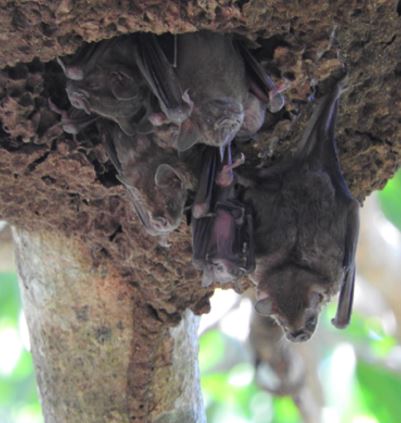Abstract
Artibeus jamaicensis was recorded using a termite nest as a day refuge between April 24 and August 17, 2021 in an orchard located 5 km of the city of Heroica Cardenas, Tabasco. The termite nest was in a mango tree (Mangifera indica) at a height of 7 m above ground level, presented termites identified as Nasutitermes nigriceps and had a cavity with a 9 cm diameter opening in its lower part. On April 24, we observed four adult bats and one juvenile perched in the cavity with the body totally or partially outside the cavity. On May 10 we observed three adults with their heads out of the hole. On August 8 we observed two adults emerging from the termite nest, and on August 17 we captured both, which corresponded to a female and a male of A. jamaicensis.
References
Alamy. 2021. Aratinga astec https://www.alamy.com/stock-photo/aratinga-astec.html Accesed 31 August 2021.
Cancello EM, Myles TG. 2000. Isoptera. In: Bousquets JL, Soriano EG, Papavero N, editores. Biodiversidad, taxonomía y biogeografía de artrópodos de México: Hacia una síntesis de su conocimiento, v.2. Universidad Nacional Autónoma de México, y Comisión Nacional para el Conocimiento y Uso de la Biodiversidad. México. pp. 295-315.
Carrera JP, Solari S, Larsen PA, Alvarado DF, Brown AD, Carrión C, Tello JS, Baker RJ. 2010. Bats of the tropical lowlands of western Ecuador. Special Publications Museum of Texas Tech University 57:1-37. https://doi.org/10.5962/bhl.title.142936
Constantino R. 2002. An illustrated key to Neotropical termite genera (Insecta: Isoptera) based primarily on soldiers. Zootaxa 67:1-40. https://doi.org/10.11646/zootaxa.67.1.1
Dechmann DKN, Kalko EKV, Kerth G. 2004. Ecology of an exceptional roost: energetic benefits could explain why the bat Lophostoma silvicolum roosts in active termite nests. Evolutionary Ecology Research. 6:1037-1050. https://doi.org/10.5167/uzh-584
Díaz-Padilla G, Ruiz-Corral JA, Medina-García G, Cano-García MA, Serrano-Altamirano V. 2006. Estadísticas climatológicas básicas del Estado de Tabasco (Período 1961-2003). INIFAP. CIRGOC. Campo Experimental Cotaxtla. Libro Técnico Núm. 12. Veracruz, México.
Ensaf A, Eggleton P. 2004. The identification of twenty species of the genus Nasutitermes (Isoptera: Termitidae) from French Guiana and the new morphological characters. Mitteilungen der Schweizerischen Entomologischen Gesellschaft 77:311-332. http://doi.org/10.5169/seals-402874
Esquivel DA, Peña S, Aya-Cuero C, Tavares VC. 2020. Bats and termite nests: roosting ecology of Lophostoma brasiliense (Chiroptera: Phyllostomidae) in Colombia. Mastozoología Neotropical 27:72-80. https://doi.org/10.31687/saremMN.20.27.1.0.11
Fleming TH 1971. Artibeus jamaicensis: delayed embryonic development in a neotropical bat. Science 171:402-404. https://doi.org/10.1126/science.171.3969.402
Fleming TH, Hooper ET, Wilson DE. 1972. Three Central American bat communities: structure, reproductive cycles, and movement patterns. Ecology 53:555-569. https://doi.org/10.2307/1934771
Hernández-Mijangos LA. 2010. Uso de termitero como refugio por Artibeus lituratus (Chiroptera: Phyllostomidae). Revista Mexicana de Mastozoología 14:59-63. https://doi.org/10.22201/ie.20074484e.2010.14.1.28
Howell SNG, Webb S. 1995. A guide to the birds of Mexico and northern Central America. Oxford University Press. New York.
Kalko EKV, Handley CO, Handley D. 1996. Organization, diversity, and long-term dynamics of a Neotropical bat community. In M. Cody and M. Smallwood (Eds.). Long-term studies in vertebrate communities, pp. 503–553. Academic Press, Los Angeles.
Kalko EKV, Ueberschaer K, Dechmann DKN. 2006. Roost structure, modification, and availability in the white-throated round-eared bat, Lophostoma silvicolum (Phyllostomidae) living in active termite nests. Biotropica 38:1-7. https://doi.org/10.1111/j.1744-7429.2006.00142.x
Malpica FH, Andara C, Varela CW. 2010. Especies de Nasutitermes (Isoptera: Termitidae) en la Cumaca, municipio San Diego, estado Carabobo, Venezuela. Faraute de Ciencias y Tecnología. 5:44-55.
Medellin RA, Arita HT, Sánchez O. 2008. Identificación de los murciélagos de México, clave de campo. Instituto de Ecología, Universidad Nacional Autónoma de México. México, D.F.
Ortega J, Castro-Arellano I. 2001. Artibeus jamaicensis. Mammalian Species 662:1-9. https://doi.org/10.2307/0.662.1
Ortega J, Guerrero JA, Maldonado JE. 2008. Aggression and tolerance by dominant males of Artibeus jamaicensis: strategies to maximize in harem groups. Journal of Mammalogy 89:1372-1378. https://doi.org/10.1644/08-MAMM-S-056.1
Sánchez-Hernández C, Romero-Almaraz ML. 1995. Murciélagos de Tabasco y Campeche una propuesta para su conservación. Cuadernos 24. Instituto de Biología, Universidad Nacional Autónoma de México. México D.F.
Sánchez-Soto S. 2018. Vertebrados silvestres observados en un huerto familiar de La Chontalpa, Tabasco, México. Revista Nicaragüense de Biodiversidad 29:1-42.
Sosa M, Ramoni-Perazzi P. 1995. Patrón reproductivo de Artibeus jamaicensis Leach, 1821 y A. lituratus (Olfers, 1818) (Chiroptera: Phyllostomidae) en una zona árida de los Andes Venezolanos. Revista Brasileira de Biologia 55:705-713.
Thorne BL, Haverty MI, Collins MS. 1994. Taxonomy and biogeography of Nasutitermes acajutlae and N. nigriceps (Isoptera: Termitidae) in the Caribbean and Central America. Annals of the Entomological Society of America 87:762-770. https://doi.org/10.1093/aesa/87.6.762

This work is licensed under a Creative Commons Attribution 4.0 International License.






